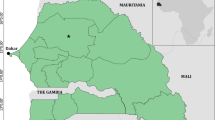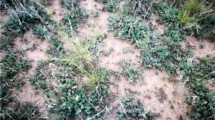Abstract
-
(1)
The influence of sheep grazing of moderate grazing (MG), heavy grazing (HG), inordinate grazing (IG), over grazing (OG), and extinct grazing (EG) on vegetation succession was studied in the Stipa baicalensis steppe during 1984–1986.
-
(2)
The relationships between the relative sum of dominance ratio (RSDR) and the degree of succession (DS) at all stages of grazing succession in the Stipa baicalensis steppe were revealed in terms of the method of mathematical analysis under five grazing intensities mentioned above.
-
(3)
The dynamic models of grazing succession that are based on accurate grazing intensities in relation to succession courses were constructed using RSDR5, and DS. The models may explain the rules of grazing succession in the Stipa baicalensis steppe.
Similar content being viewed by others
References
Abrahamsos, W. G. 1979. Patterns of resource allocation in wilaflower populations of fields and woods. Amer. J. bot. 66: 71–79.
ChenQingcheng, 1981. Mathematical models of retrogression of population under grazing condition in the Stipa steppe. Acta Botanica Sinica of China 23: 323–328.
Clements, F. 1982. Plant indicators vegetation in ‘The British Islands & their Vegetation’. 213–233.
Floyd, D. A. & Anderson, J. E. 1982. A new point interception fram for estimating cover of vegetation. Vegetatio 50: 185–186.
Hayashi, I. 1984a. Secondary succession of herbaceous communities in JAPAN: Quantitative features of the growth form of succession dominants. Japanese Journal of Ecology 34: 47–53.
Hayashi, I. 1984b. Secondary succession of herbaceous communities in JAPAN: Seed production of successional dominants. Japanese Journal of Ecology 34: 375–382.
Jia Shenxiu, 1982. Grassland Science. Agricultural Publishing House of China 210–238.
Li Shiying & Xiao Yunfeng, 1964. A preliminary study in dividing the grazing succession stages in the Leymus chinensis steppe in Modamuji area, Hulunbeir Rangeland. Acta Phytoecologico et Geobotanica Sinica of China No. 4: 19–33.
Noy-Meir, I. 1975. Stability of grazing systems: An application of predator-prey graphs. J. Ecology 63: 459–481.
Numata, M. 1978. Handbook of survey method of grassland (Chinese edition, 1986. Scientific publishing House of China 79–234). The Publishing House of The University of Tokyo.
Pearson, L. C. 1965. Primary production in grazed and ungrazed desert communities of eo-serm Idaho. Ecology 40: 278–285.
van der Valk, A. G. 1981. Succession in wetlands: a gleasonian approach. Ecology 62: 688–696.
WangYusheng & SunAizhi, 1984. Nutrient status of grassland communities in Southern Duerbaite, Mongolian Autonmoys County of Heilongjiang Province and rational sheep stocking density. Chinese the Journal of Ecology 6: 17–21.
WangYusheng, ZhaoNishann & XuZhongru, 1991. The relationships between primary production and the major ecological factores and its prediction models in Stipa baicalensis steppe in Northeastern China. Vegetatio 96: 15–23.
WangYifeng, 1985. The vegetation of Inner Mongolia: Stipa baicalensis steppe. Science Press, China 390–403.
Wear, J. E. 1954. A seventeen-years study of plant succession in Aprairie. Amer. J. Bot. 41: 31–38.
Zheng Shaolian, 1979. The theory of probability and statistics. Scientific Publishing House of China 101–293.
Zhu Tingcheng, 1986. Grassland resources and further development of grassland farming in temperate China. Grassland of China, No. 3 (Cumulated No. 29) 1–7.
Zhu Tingcheng, 1983. A study of the ecology of Yan-Cao (Leymus chinensis) grassland in Northern China. In: Proceedings of the XIV international grassland congress (Ed. by J. Allan Smith and Virgil W. Hays) Kentucky USA. 429–431.
Author information
Authors and Affiliations
Rights and permissions
About this article
Cite this article
Yusheng, W. Vegetation dynamics of grazing succession in the Stipa baicalensis steppe in Northeastern China. Vegetatio 98, 83–95 (1992). https://doi.org/10.1007/BF00031639
Accepted:
Issue Date:
DOI: https://doi.org/10.1007/BF00031639




